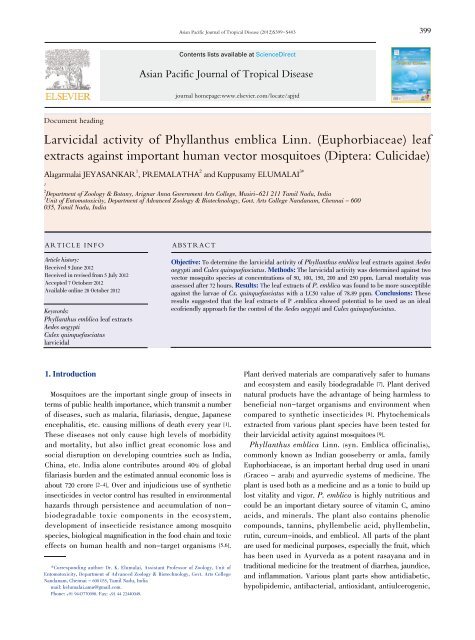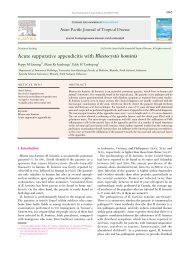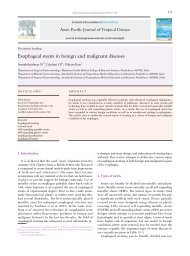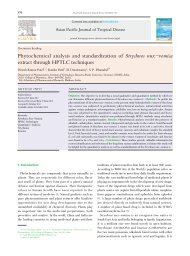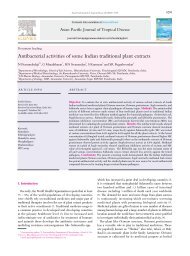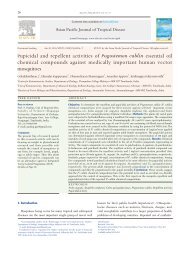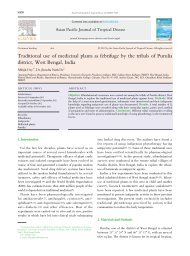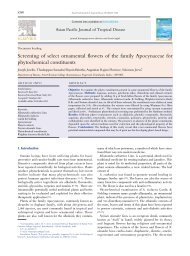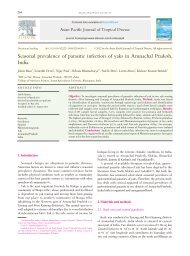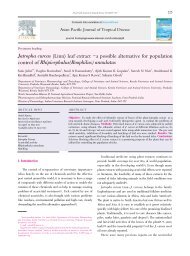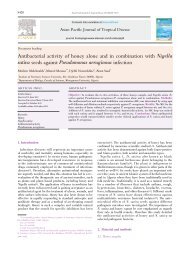Larvicidal activity of Phyllanthus emblica Linn ... - Apjtcm.com
Larvicidal activity of Phyllanthus emblica Linn ... - Apjtcm.com
Larvicidal activity of Phyllanthus emblica Linn ... - Apjtcm.com
Create successful ePaper yourself
Turn your PDF publications into a flip-book with our unique Google optimized e-Paper software.
Document heading<br />
<strong>Larvicidal</strong> <strong>activity</strong> <strong>of</strong> <strong>Phyllanthus</strong> <strong>emblica</strong> <strong>Linn</strong>. (Euphorbiaceae) leaf<br />
extracts against important human vector mosquitoes (Diptera: Culicidae)<br />
Alagarmalai JEYASANKAR 1 , PREMALATHA 2 and Kuppusamy ELUMALAI 3*<br />
1<br />
2<br />
Department <strong>of</strong> Zoology & Botany, Arignar Anna Government Arts College, Musiri-621 211 Tamil Nadu, India<br />
3<br />
Unit <strong>of</strong> Entomotoxicity, Department <strong>of</strong> Advanced Zoology & Biotechnology, Govt. Arts College Nandanam, Chennai - 600<br />
035, Tamil Nadu, India<br />
ARTICLE INFO ABSTRACT<br />
Article history:<br />
Received 9 June 2012<br />
Received in revised from 5 July 2012<br />
Accepted 7 Octoberr 2012<br />
Available online 28 October 2012<br />
Keywords:<br />
<strong>Phyllanthus</strong> <strong>emblica</strong> leaf extracts<br />
Aedes aegypti<br />
Culex quinquefasciatus<br />
larvicidal<br />
1. Introduction<br />
Asian Pacific Journal <strong>of</strong> Tropical Disease (2012)S399-S403<br />
Asian Pacific Journal <strong>of</strong> Tropical Disease<br />
Mosquitoes are the important single group <strong>of</strong> insects in<br />
terms <strong>of</strong> public health importance, which transmit a number<br />
<strong>of</strong> diseases, such as malaria, filariasis, dengue, Japanese<br />
encephalitis, etc. causing millions <strong>of</strong> death every year [1].<br />
These diseases not only cause high levels <strong>of</strong> morbidity<br />
and mortality, but also inflict great economic loss and<br />
social disruption on developing countries such as India,<br />
China, etc. India alone contributes around 40% <strong>of</strong> global<br />
filariasis burden and the estimated annual economic loss is<br />
about 720 crore [2-4]. Over and injudicious use <strong>of</strong> synthetic<br />
insecticides in vector control has resulted in environmental<br />
hazards through persistence and accumulation <strong>of</strong> nonbiodegradable<br />
toxic <strong>com</strong>ponents in the ecosystem,<br />
development <strong>of</strong> insecticide resistance among mosquito<br />
species, biological magnification in the food chain and toxic<br />
effects on human health and non-target organisms [5,6].<br />
*Corresponding author: Dr. K. Elumalai, Assistant Pr<strong>of</strong>essor <strong>of</strong> Zoology, Unit <strong>of</strong><br />
Entomotoxicity, Department <strong>of</strong> Advanced Zoology & Biotechnology, Govt. Arts College<br />
Nandanam, Chennai - 600 035, Tamil Nadu, India<br />
mail: kelumalai.amu@gmail.<strong>com</strong>.<br />
Phone: +91 9443770090. Fax: +91 44 22440049.<br />
Contents lists available at ScienceDirect<br />
journal homepage:www.elsevier.<strong>com</strong>/locate/apjtd<br />
399<br />
Objective: To determine the larvicidal <strong>activity</strong> <strong>of</strong> <strong>Phyllanthus</strong> <strong>emblica</strong> leaf extracts against Aedes<br />
aegypti and Culex quinquefasciatus. Methods: The larvicidal <strong>activity</strong> was determined against two<br />
vector mosquito species at concentrations <strong>of</strong> 50, 100, 150, 200 and 250 ppm. Larval mortality was<br />
assessed after 72 hours. Results: The leaf extracts <strong>of</strong> P. <strong>emblica</strong> was found to be more susceptible<br />
against the larvae <strong>of</strong> Cx. quinquefasciatus with a LC50 value <strong>of</strong> 78.89 ppm. Conclusions: These<br />
results suggested that the leaf extracts <strong>of</strong> P .<strong>emblica</strong> showed potential to be used as an ideal<br />
ec<strong>of</strong>riendly approach for the control <strong>of</strong> the Aedes aegypti and Culex quinquefasciatus.<br />
Plant derived materials are <strong>com</strong>paratively safer to humans<br />
and ecosystem and easily biodegradable [7]. Plant derived<br />
natural products have the advantage <strong>of</strong> being harmless to<br />
beneficial non-target organisms and environment when<br />
<strong>com</strong>pared to synthetic insecticides [8]. Phytochemicals<br />
extracted from various plant species have been tested for<br />
their larvicidal <strong>activity</strong> against mosquitoes [9].<br />
<strong>Phyllanthus</strong> <strong>emblica</strong> <strong>Linn</strong>. (syn. Emblica <strong>of</strong>ficinalis),<br />
<strong>com</strong>monly known as Indian gooseberry or amla, family<br />
Euphorbiaceae, is an important herbal drug used in unani<br />
(Graceo - arab) and ayurvedic systems <strong>of</strong> medicine. The<br />
plant is used both as a medicine and as a tonic to build up<br />
lost vitality and vigor. P. <strong>emblica</strong> is highly nutritious and<br />
could be an important dietary source <strong>of</strong> vitamin C, amino<br />
acids, and minerals. The plant also contains phenolic<br />
<strong>com</strong>pounds, tannins, phyllembelic acid, phyllembelin,<br />
rutin, curcum-inoids, and emblicol. All parts <strong>of</strong> the plant<br />
are used for medicinal purposes, especially the fruit, which<br />
has been used in Ayurveda as a potent rasayana and in<br />
traditional medicine for the treatment <strong>of</strong> diarrhea, jaundice,<br />
and inflammation. Various plant parts show antidiabetic,<br />
hypolipidemic, antibacterial, antioxidant, antiulcerogenic,
400<br />
hepatoprotective, gastroprotective, and chemopreventive<br />
properties [10]. The leaf extracts <strong>of</strong> this plant exhibited<br />
adulticidal and larvicidal properties against the adult cattle<br />
tick Haemaphysalis bispinosa Neumann, 1897 (Acarina:<br />
Ixodidae), sheep fluke Paramphistomum cervi Zeder, 1790<br />
(Digenea: Paramphistomatidae), fourth instar larvae <strong>of</strong><br />
malaria vector, Anopheles subpictus Grassi and Japanese<br />
encephalitis vector, Culex tritaeniorhynchus Giles (Diptera:<br />
Culicidae) [11]. Therefore the present study was carried<br />
out to determine the larvicidal <strong>activity</strong> <strong>of</strong> P. <strong>emblica</strong> leaf<br />
extracts against important vectors Aedes aegypti and Culex<br />
quinquefasciatus.<br />
2. Materials and methods<br />
2.1 Plant collection and extraction<br />
P. <strong>emblica</strong> leaves collected in and around Tiruchirapalli<br />
district, Tamil Nadu, India were brought to the laboratory<br />
at PG and Research Depaerment <strong>of</strong> Zoology, Arignar Anna<br />
Government Arts College, Musiri, Tiruchirapalli, Tamil<br />
Nadu, India.; shade dried under room temperature and<br />
powdered using an electric blender. A total <strong>of</strong> 1 kg <strong>of</strong> dried<br />
and powdered leaves was subjected to sequential extraction<br />
using 3 L <strong>of</strong> hexane, diethyl ether and ethyl acetate for<br />
a period <strong>of</strong> 72 h to obtain the crude extracts using rotary<br />
vacuum evaporator. The hexane, diethyl ether, and ethyl<br />
acetate crude extracts thus obtained were lyophilized<br />
and a stock solution <strong>of</strong> 100 000 ppm prepared from each<br />
crude extract by adding adequate volume <strong>of</strong> acetone was<br />
refrigerated at 4 °C until testing for bioassays.<br />
2.2. Test organisms<br />
All tests were carried out against laboratory reared vector<br />
mosquitoes viz., Aedes aegypti (Ae. aegypti) and Culex<br />
quinquefasciatus (Cx. quinquefasciatus) free <strong>of</strong> exposure to<br />
insecticides and pathogens. Cyclic generations <strong>of</strong> vector<br />
mosquitoes were maintained at 25-29 °C and 80-90 %<br />
relative humidity in the insectarium. Larvae were fed on<br />
larval food (powdered dog biscuit and yeast in the ratio <strong>of</strong> 3:1)<br />
and adult mosquitoes on 10 % glucose solution. Adult female<br />
mosquitoes were periodically blood-fed on restrained albino<br />
mice for egg production.<br />
2.3. <strong>Larvicidal</strong> <strong>activity</strong><br />
Standard WHO protocol with slight modifications<br />
was adopted for the study [12]. From the stock solution,<br />
concentrations <strong>of</strong> 50, 100, 150, 200 and 250 ppm were<br />
prepared. Twenty five early third instar larvae were<br />
introduced in 250 mL beaker containing 200 mL <strong>of</strong> water with<br />
each concentration. A control was prepared by the addition<br />
<strong>of</strong> acetone to water. Mortality was recorded after 72 hours.<br />
Alagarmalai JEYASANKAR et al./Asian Pacific Journal <strong>of</strong> Tropical Disease (2012)S399-S403<br />
A total <strong>of</strong> three trials were carried out with five replicates<br />
per trial against vector mosquitoes. However, when the<br />
control mortality ranged from 5-20 per cent, the observed<br />
percentage mortality was corrected by Abbott’s formula [13],<br />
2.4. Statistical analysis<br />
SPSS 11.5 version package was used for determination<br />
<strong>of</strong> LC 50 and LC 90 [14]. Data from mortality and effect <strong>of</strong><br />
concentrations were subjected to analysis <strong>of</strong> variance.<br />
The percentage data obtained was angular transformed.<br />
Difference between the treatments was determined by<br />
Tukey’s test (P < 0.05).<br />
3. Results<br />
Larval toxicity <strong>of</strong> leaf extracts <strong>of</strong> P. <strong>emblica</strong> against Ae.<br />
aegypti, and Cx. quinquefasciatus reported in the present<br />
study exhibit the mosquitocidal properties in the plant<br />
leaf extracts suggesting their use in mosquito population<br />
control (Tables 1- 3). The different solvent crude extracts <strong>of</strong><br />
P. <strong>emblica</strong> showed promising larval mortality against two<br />
important mosquito vectors. According to the data, larvae<br />
<strong>of</strong> Cx. quinquefasciatus were more susceptible than Ae.<br />
Aegypti. The data pertaining to the hexane extract <strong>of</strong> P.<br />
<strong>emblica</strong> against the fourth instar larvae <strong>of</strong> A. aegypti and C.<br />
quinquefasciatus are shown in table 1. The larval mortality <strong>of</strong><br />
the A. aegypti was more prominent than C. quinquefasciatus<br />
as evidenced from the table 1, which showed 86.0% mortality<br />
in A. aegypti whereas, 73.6% larval mortality was recorded in<br />
C.quinquefasciatus at 250ppm concentration with the LC50<br />
<strong>of</strong> 111.34 (LCL=93.07 - UCL=133.20) and LC 50 <strong>of</strong> 136.78ppm<br />
(LCL=113.21 - UCL=165.25) respectively. Similar trend <strong>of</strong><br />
larval toxicity was also observed in diethyl ether extract <strong>of</strong><br />
P. <strong>emblica</strong> against the selected two vector mosquito species<br />
(Table 2). Besides, the ethyl acetate extract <strong>of</strong> P. <strong>emblica</strong><br />
exhibited the maximum larvicidal <strong>activity</strong> (99.6%) with LC50<br />
value <strong>of</strong> 78.89 ppm against the larvae <strong>of</strong> Ae. aegypti. The<br />
screening <strong>of</strong> local medicinal plants for mosquito larvicidal<br />
<strong>activity</strong> may eventually lead to their use in natural productbased<br />
mosquito abatement practices.<br />
4. Discussion<br />
The results <strong>of</strong> present study are <strong>com</strong>parable with similar<br />
reports <strong>of</strong> earlier workers. Bhagan et al [11] who have<br />
been reported that ethyl acetate and methanol extracts<br />
<strong>of</strong> P. <strong>emblica</strong> showed highest larval mortality against C.<br />
tritaeniorhynchus with LC 50 = 54.82 ppm; LC 90 199.89 ppm,<br />
respectively and adult mortality was found in leaf methanol<br />
extracts against H. bispinosa and P. cervi with LC 50 = 256.08;<br />
60.60 ppm; LC 90 = 1025.60; 287.48 ppm respectively. Sharma<br />
et al [15] reported that, petroleum ether extract <strong>of</strong> Ageratum
conyzoides leaves exhibited larvicidal <strong>activity</strong> with LC 50<br />
value <strong>of</strong> 425.60 and 267.90 ppm after 24 and 48 h <strong>of</strong> exposure.<br />
The toxicity to the third instar larvae <strong>of</strong> Cx. quinquefasciatus<br />
by methanolic leaf extract <strong>of</strong> Memordica charantia,<br />
Trichosanthus anguina and Luffa acutangula showed the<br />
LC 50 values <strong>of</strong> 465.85, 567.81 and 839.81 ppm respectively<br />
[16]. The toxicity to the late third instar larvae <strong>of</strong> Ae. aegypti<br />
by the hexane leaf extracts <strong>of</strong> Abutilon indicum and Cx.<br />
quinquefasciatus by dichloromethane whole plant extracts <strong>of</strong><br />
Citrullus colocynthis and hexane extracts <strong>of</strong> aerial parts <strong>of</strong><br />
Hyptis suaveolens was reported by Arivoli and Samuel [17-<br />
19]. Jang et al[20] have reported that the methanol extracts<br />
<strong>of</strong> Cecropia obtusifolia, Cassia tora and Vicia tetrasperma<br />
Alagarmalai JEYASANKAR et al./Asian Pacific Journal <strong>of</strong> Tropical Disease (2012)S399-S403 401<br />
Table 1<br />
<strong>Larvicidal</strong> <strong>activity</strong> <strong>of</strong> hexane extracts <strong>of</strong> <strong>Phyllanthus</strong> <strong>emblica</strong> against 4th instar larvae <strong>of</strong> A. aegypti and C. quinquefasciatus<br />
Concentration (ppm) Mortality* (%) LC 50 (ppm) 95%Confidence Limits (ppm) LC 90 (ppm)<br />
Aedes aegypti<br />
Control 1.2 依 1.3 a<br />
50 25.4 依 2.1b<br />
100 44.3 依 2.0 c<br />
150 52.4 依 1.5 d<br />
200 70.2 依 1.6 e<br />
250<br />
Culex quinquefasciatus<br />
86.0 依 2.4 f<br />
Control 1.1 依 1.2 a<br />
50 21.2 依 1.3 b<br />
100 35.6 依 1.6 c<br />
150 49.4 依 2.6 d<br />
200 62.6 依 1.6 e<br />
250 73.2 依 1.2 f<br />
95%Confidence Limits (ppm) Degrees <strong>of</strong><br />
freedom χ2value<br />
LCL UCL LCL UCL<br />
111.34 93.07 133.20 617.50 366.90 1039.28 4 4.2548<br />
136.78 113.21 165.25 939.01 465.67 1893.49 4 0.8128<br />
Value represents mean 依 S.D. <strong>of</strong> five replications. *Mortality <strong>of</strong> the larvae observed after 72h <strong>of</strong> exposure period. LC 50=Lethal Concentration<br />
brings out 50% mortality and LC 90 = Lethal Concentration brings out 90% mortality. LCL = Lower Confidence Limit; UCL = Upper Confidence Limit;<br />
Values in a column with a different superscript alphabet are significantly different at P < 0.05 level DMRTTest<br />
Table 2<br />
<strong>Larvicidal</strong> <strong>activity</strong> <strong>of</strong> diethyl ether extracts <strong>of</strong> <strong>Phyllanthus</strong> <strong>emblica</strong> against 4th instar larvae <strong>of</strong> A. aegypti and C. quinquefasciatus<br />
Concentration (ppm) Mortality* (%) LC 50 (ppm) 95%Confidence Limits (ppm) LC 90 (ppm)<br />
Aedes aegypti<br />
Control 1.0 依 0.5 a<br />
50 17.2 依 1.6b<br />
100 50.7 依 1.2 c<br />
150 66.4 依 1.8 d<br />
200 82.3 依 1.6 e<br />
250<br />
Culex quinquefasciatus<br />
94.5 依 2.4 f<br />
Control 1.1 依 0.6 a<br />
50 39.5 依 2.6 b<br />
100 58.1 依 1.9 c<br />
150 69.2 依 2.4 d<br />
200 88.6 依 1.5e<br />
250 98.2 依 2.2 f<br />
95%Confidence Limits (ppm) Degrees <strong>of</strong><br />
freedom χ2value<br />
LCL UCL LCL UCL<br />
114.77 102.81 125.51 333.50 206.44 243.71 4 4.133<br />
82.65 65.37 96.36 206.65 189.03 230.90 4 4.058<br />
Value represents mean 依 S.D. <strong>of</strong> five replications. *Mortality <strong>of</strong> the larvae observed after 72h <strong>of</strong> exposure period. LC 50=Lethal Concentration<br />
brings out 50% mortality and LC 90 = Lethal Concentration brings out 90% mortality. LCL = Lower Confidence Limit; UCL = Upper Confidence Limit;<br />
Values in a column with a different superscript alphabet are significantly different at P < 0.05 level DMRT Test.<br />
exhibited more than 90% larval mortality at 200 ppm on<br />
Ae. aegypti and Culex pipiens. The larvicidal <strong>activity</strong> <strong>of</strong><br />
petroleum ether, ethanolic, aqueous extracts <strong>of</strong> dried leaves<br />
and fixed oil from the seeds <strong>of</strong> Caesalpinia bonduc (Family:<br />
Caesalpiniaceae) showed 100% mortality in 1% concentration<br />
<strong>of</strong> petroleum ether and ethanolic extract <strong>of</strong> leaf, whereas<br />
it was 55.0% in 2.5% concentration <strong>of</strong> aqueous extract and<br />
92.6% in 2.5% concentration <strong>of</strong> fixed oil against the fourth<br />
instar larvae <strong>of</strong> Cx. quinquefasciatus[21]; the petroleum ether<br />
extract <strong>of</strong> Solanum xanthocarpum was observed to be the<br />
most toxic with LC50 <strong>of</strong> 1.41 and 0.93 ppm and LC 90 <strong>of</strong> 16.94<br />
and 8.48 ppm at 24 and 48 h after application, respectively<br />
against An. stephensi[22]. The Ricinus <strong>com</strong>munis seed extract
402<br />
Table 3<br />
exhibited larvicidal effects with 100% killing activities at<br />
concentrations 32-64 毺g/mL, and with LC50 values 7.10, 11.64<br />
and 16.84 毺g/mL for C. quinquefasciatus, An. stephensi and<br />
Ae. albopictus larvae, respectively[23]. Venkatachalam and<br />
Jebanesan[24] have also reported that the repellent <strong>activity</strong> <strong>of</strong><br />
methanol extract <strong>of</strong> Ferronia elephantum leaves against Ae.<br />
aegypti <strong>activity</strong> at 1.0 mg/cm2 and 2:5 mg/cm2 concentrations<br />
gave 100% protection up to (2.14依0.16) h and (4.00依0.24) h,<br />
respectively, and the total percentage protection was 45.8%<br />
at 1.0 mg/ cm 2<br />
and 59.0% at 2.5 mg/cm2 for 10 h. The essential<br />
oil <strong>of</strong> Zingiber <strong>of</strong>ficinalis showed repellent <strong>activity</strong> at 4.0 mg/<br />
cm 2<br />
, which provided 100% protection up to 120 min against<br />
C. quinquefasciatus[31].<br />
The findings <strong>of</strong> the present investigation revealed that<br />
the leaf extracts <strong>of</strong> P. <strong>emblica</strong> possess larvicidal <strong>activity</strong><br />
against vector mosquitoes. It may concluded that natural<br />
products as extracts from parts <strong>of</strong> plants <strong>of</strong> insecticidal<br />
and medicinal values have higher efficiency in reducing<br />
mosquito menace due to their larvicidal toxicity. Further<br />
studies on the screening, isolation and purification <strong>of</strong><br />
bioactive phytochemical constituents/<strong>com</strong>pounds followed<br />
by in-depth laboratory and field bioassays are needed as the<br />
present study shows that there is scope to use P. <strong>emblica</strong> leaf<br />
extracts to control the immature stages <strong>of</strong> vector mosquitoes.<br />
In conclusion, an attempt has been made to evaluate the role<br />
<strong>of</strong> P. <strong>emblica</strong> against an alternative approach to <strong>com</strong>bat with<br />
the important human vector mosquitoes.<br />
Conflict <strong>of</strong> interests<br />
We declare that we have no conflict <strong>of</strong> interests.<br />
Alagarmalai JEYASANKAR et al./Asian Pacific Journal <strong>of</strong> Tropical Disease (2012)S399-S403<br />
<strong>Larvicidal</strong> <strong>activity</strong> <strong>of</strong> Ethyl acetate extracts <strong>of</strong> <strong>Phyllanthus</strong> <strong>emblica</strong> against 4th instar larvae <strong>of</strong> A. aegypti and C. quinquefasciatus<br />
Concentration (ppm) Mortality* (%) LC 50 (ppm) 95%Confidence Limits (ppm) LC 90 (ppm)<br />
Aedes aegypti<br />
Control 0.0 依 0.0 a<br />
50 35.7 依 1.6b<br />
100 52.8 依 2.4 c<br />
150 66.4 依 2.8 d<br />
200 88.2 依 1.6 e<br />
250<br />
Culex quinquefasciatus<br />
99.5 依 2.4 f<br />
Control 0.0 依 0.0 a<br />
50 39.2 依 1.6 b<br />
100 55.6 依 2.2 c<br />
150 59.4 依 2.5 d<br />
200 74.6 依 1.4 e<br />
250 99.6 依 2.2 f<br />
95%Confidence Limits (ppm) Degrees <strong>of</strong><br />
freedom χ2value<br />
LCL UCL LCL UCL<br />
80.04 66.27 96.67 332.53 233.06 474.45 4 10.552<br />
78.89 61.59 101.05 502.10 280.23 899.63 4 18.387<br />
Value represents mean 依 S.D. <strong>of</strong> five replications. *Mortality <strong>of</strong> the larvae observed after 72h <strong>of</strong> exposure period. LC 50=Lethal Concentration<br />
brings out 50% mortality and LC 90 = Lethal Concentration brings out 90% mortality. LCL = Lower Confidence Limit; UCL = Upper Confidence Limit;<br />
Values in a column with a different superscript alphabet are significantly different at P < 0.05 level DMRT Test.`<br />
Acknowledgements<br />
The authors are grateful to Principal and HOD <strong>of</strong> Zoology<br />
Department, Arignar Anna Govt. Arts College, Musiri, Tamil<br />
Nadu, India for their help and suggestion. This work was<br />
conducted in laboratory which is financially supported by<br />
University Grant Commission (UGC) X plan (UGC/TN/GAC<br />
-2008) for college teachers.<br />
References<br />
[1] Das NG, Goswami D, Rabha B. Preliminary evaluation <strong>of</strong> mosquito<br />
larvicidal efficacy <strong>of</strong> plant extracts. J Vect Borne Dis 2007; 44:145-<br />
148.<br />
[2] Hotez PJ, Remme JHF, Buss P, Alleyne G, Morel C, Breman JG.<br />
Combating tropical infectious diseases: report <strong>of</strong> the disease<br />
control priorities in developing countries project. Clin Infect Dis<br />
2004; 38: 871-878.<br />
[3] Rahuman AA, Bagavan A, Kamaraj C, Saravanan E, Zahir AA,<br />
Elango G. Efficacy <strong>of</strong> larvicidal botanical extracts against Culex<br />
quinquefasciatus Say (Diptera: Culicidae). Parasitol Res 2009; 104:<br />
1365-1372.<br />
[4] Kamaraj C, Rahuman AA, Bagavan A, Elango G, Zahir AA,<br />
Santhoshkumar T. <strong>Larvicidal</strong> and repellent <strong>activity</strong> <strong>of</strong> medicinal<br />
plant extracts from Eastern Ghats <strong>of</strong> South India against malaria<br />
and filariasis vectors. Asian Pac J Trop Med 2011; 698-705.<br />
[5] Bansal SK, Singh KV, Sharma S, Sherwani MRK. Comparative<br />
larvicidal potential <strong>of</strong> different plant parts <strong>of</strong> Withania somnifera<br />
against vector mosquitoes in the semi-arid region <strong>of</strong> Rajasthan. J<br />
Environ Biol 2011; 32 (1): 71-75.<br />
[6] Devine GJ, Furlong MJ. Insecticide use: Contexts and ecological
successions. Agr Human Values 2007; 24: 281-306.<br />
[7] Kalu IJ, Ofoegbu U, Eroegbusi J, Nwachukwu CU, Ibeh B.<br />
<strong>Larvicidal</strong> activities <strong>of</strong> ethanol extract <strong>of</strong> Allium sativum (garlic<br />
bulb) against the filarial vector, Culex quinquefasciatus. J Med<br />
Plant Res 2010; 4 (6): 496-498.<br />
[8] Pitasawat B, Champakaew D, Choochote W, Jitpakdi A, Chaithong<br />
U, Kanjanapothi R, et al. Aromatic plant-derived essential oil: An<br />
alternative larvicide for mosquito control. Fitoterapia 2007; 78:205-<br />
210<br />
[9] Pavela R. <strong>Larvicidal</strong> effects <strong>of</strong> various Euro-Asiatic plants against<br />
Culex quinquefasciatus Say larvae (Diptera: Culicidae). Parasitol<br />
Res 2008; 102: 555-559.<br />
[10] Krishnaveni M, Mirunalini S. Therapeutic potential <strong>of</strong> <strong>Phyllanthus</strong><br />
<strong>emblica</strong> (amla): the ayurvedic wonder. J Basic Clin Physiol<br />
Pharmacol. 2010;21 (1):93-105.<br />
[11] Bagavan A, Kamaraj C, Elango G, Abduz Zahir A, Abdul<br />
Rahuman A. Adulticidal and larvicidal efficacy <strong>of</strong> some medicinal<br />
plant extracts against tick, fluke and mosquitoes. Veterinary<br />
Parasitology. 2009; 166:286-292.<br />
[12] WHO. Report <strong>of</strong> the WHO informal consultation on the evaluation<br />
and testing <strong>of</strong> insecticides. CTD/WHOPES/IC/96. 1. Geneva: Control<br />
<strong>of</strong> Tropical Diseases Division; 1996.<br />
[13] Abbott WS. A method <strong>of</strong> <strong>com</strong>puting the effectiveness <strong>of</strong> an<br />
insecticide. J Eco Entomol 1925; 18: 265-267.<br />
[14] SPSS. SPSS for windows, version 11.5. Chicago, IL: SPSS; 2007.<br />
[15] Sharma P, Mohan L, Srivastava CN. Anti-juvenile <strong>activity</strong> <strong>of</strong><br />
Azadirachta indica extract on the development and morphometry<br />
<strong>of</strong> filaria vector, Culex quinquefasciatus (Diptera: Culicidae) Say.<br />
Parasitol Res 2009; 105: 1193-1203.<br />
[16] Prabakar K, Jebanesan A. <strong>Larvicidal</strong> efficacy <strong>of</strong> some<br />
cucurbitaceous plant leaf extracts against Culex quinquefasciatus<br />
(Say). Bioresour Technol 2004; 95: 113-114.<br />
[17] Arivoli S, Samuel T. <strong>Larvicidal</strong> and adult emergence inhibition <strong>of</strong><br />
Alagarmalai JEYASANKAR et al./Asian Pacific Journal <strong>of</strong> Tropical Disease (2012)S399-S403 403<br />
Abutilon indicum (<strong>Linn</strong>.) (Malvaceae) leaf extracts against vector<br />
mosquitoes. J Biopest 2011; 4 (1): 27-35.<br />
[18] Arivoli S, Samuel T. Bioefficacy <strong>of</strong> Citrullus colocynthis (L.) Schrad<br />
(Cucurbitaceae) whole plant extracts against Anopheles stephensi,<br />
Aedes aegypti and Culex quinquefasciatus (Diptera: Culicidae). Int<br />
J Curr Res 2011; 3 (4): 296-304.<br />
[19] Arivoli S, Samuel T. Mosquitocidal <strong>activity</strong> <strong>of</strong> Hyptis suaveolens<br />
(L) Poit (Lamiaceae) extracts against Aedes aegypti, Anopheles<br />
stephensi and Culex quinquefasciatus (Diptera: Culicidae). Int J<br />
Rec Sci Res 2011; 2 (5): 143 -149.<br />
[20] Jang YS, Baek BR, Yang YC, Kim MK, Lee HS. <strong>Larvicidal</strong> <strong>activity</strong><br />
<strong>of</strong> leguminous seeds and grains against Aedes aegypti and Culex<br />
pipiens pallens. J Am Mosq Control Assoc 2002; 18(3): 210-3.<br />
[21] Saravanan KS, Periyanayagam K, Ismail M. Mosquito larvicidal<br />
properties <strong>of</strong> various extract <strong>of</strong> leaves and fixed oil from the seeds<br />
<strong>of</strong> Caesalpinia bonduc (L) Roxb. J Commun Dis 2007; 39(3): 153-7.<br />
[22] Mohan L, Sharma P, Srivastava CN. Comparative efficacy <strong>of</strong><br />
Solanum xanthocarpum extracts alone and in <strong>com</strong>bination with<br />
a synthetic pyrethroid, cypermethrin, against malaria vector,<br />
Anopheles stephensi. Southeast Asian J Trop Med Public Health<br />
2007; 38(2): 256-60.<br />
[23] Shyamapada M. Exploration <strong>of</strong> larvicidal and adult emergence<br />
inhibition activities <strong>of</strong> Ricinus <strong>com</strong>munis seed extract against<br />
three potential mosquito vectors in Kolkata, India. Asian Pac J<br />
Trop Med 2010; 605-9.<br />
[24] Venketachalam MR, Jebanesan A. Repellent <strong>activity</strong> <strong>of</strong> Ferronia<br />
elephantum Corr. (Rutaceae) leaf extract against Aedes aegypti.<br />
Biores Technol 2001; 76(3): 287-8.<br />
[25] Pushpanathan T, Jebanesan A. The essential oil <strong>of</strong> Zingiber<br />
<strong>of</strong>ficinalis <strong>Linn</strong> (Zingiberaceae) as a mosquito larvicidal and<br />
repellent agent against the filarial vector Culex quinquefasciatus<br />
Say (Diptera: Culicidae). Parasitol Res 2008; 102: 1289-91.


